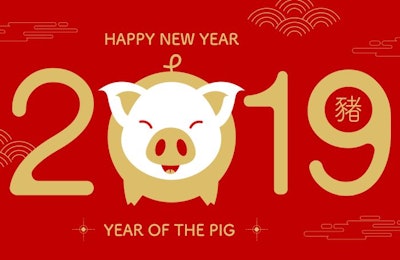
The Lunar New Year is here and, ironically enough, it has been dubbed the Year of the Pig.
But with the global pig disease situation, specifically in terms of African swine fever (ASF), it seems like it can hardly be called the Year of the Pig.
So far, in the calendar year 2019, the World Organisation for Animal Health (OIE) has active reports on ASF cases in Romania, Moldova, Belgium, Ukraine, Chad, Poland, Latvia, Mongolia, Hungary and, perhaps most importantly, the world’s largest pork-consuming country, China.
There have also been reports of foot-and-mouth disease (FMD) in Russia and Columbia, and classical swine fever in Japan.
And while most cases so far have occurred in wild boars or in small backyard herds, the threat of these diseases is real.
Maybe the Year of Pork Market Uncertainty?
In its most recent Pork Quarterly report, Rabobank reported that rising disease pressures are challenging the global pork market. The report notes that China’s need to lift imports will incentivize continued growth in key exporting countries, but it still remains uncertain how much pork China will import.
In China, Rabobank reported, ASF is reshaping the industry, and production expansion and replenishment are expected to slow, largely over biosecurity concerns. The supply of pork is sufficient to meet the demand in the first quarter of 2019, but local supply shortages can be expected in the subsequent quarters.
In the EU, the pork market is being hampered by ASF, and rising piglet prices in recent months signal a tight piglet supply.
In the U.S., pork production is expected rise 4 percent in 2019 with a large breeding herd and expectations of stronger demand from China, despite the uncertainty of the U.S.-China trade talks. The U.S.-based National Pork Producers Council (NPPC) has urged negotiators from both countries to quickly resolve their trade dispute, and has asked China to make a minimum purchase of US$3.5 billion worth of U.S. pork.
In Brazil, the pork industry is expected to have promising prospects, and export growth is expected to be driven by China. The recent return of the Russian market, through the recertification of some Brazilian pork plants, are also expected to contribute to more pork exports.
Perhaps it’s another animal’s year
In the same Rabobank report, Chenjun Pan, Senior Analyst – Animal Protein, said, “The changes ASF will bring create opportunities for some, and threats for others.”
That could apply to producers of other proteins. So while 2019 may informally be the “Year of the Pig,” it could informally be the “Year of the Chicken” or the “Year of the Turkey”. We’ll see how things unfold for the rest of the year.
















